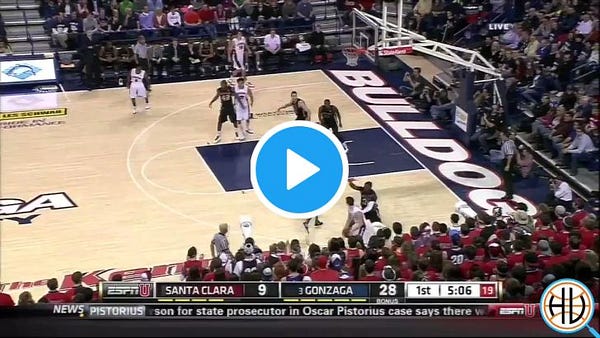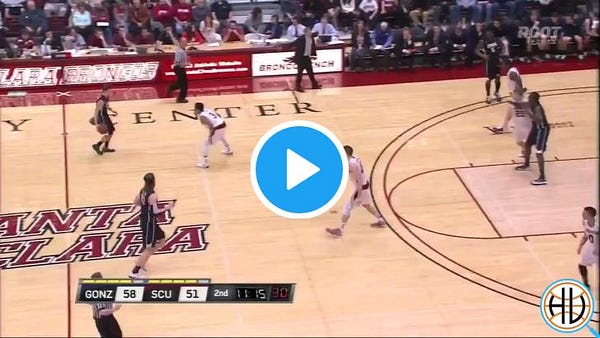The Lowdown on Hi-Lo (HV Weekly: 7/12/2020)
A new analytics presentation + Gonzaga's hi-lo offense.
Welcome back to the Hoop Vision Weekly!
In today’s edition:
A new presentation available for Hoop Vision Plus subscribers
Gonzaga’s hi-lo offense
HV+ Presentation: Basketball Analytics for Basketball Coaches
There is a lot of time and energy in the basketball analytics community spent on evaluating teams and players in different ways. Kenpom ranks teams on strength, Wins Above Bubble ranks teams on resume, and Real Plus-Minus ranks players on impact.
These ratings all have value for different tasks. If you want to predict who will a game, kenpom is a great place to start. If you want to select a fair NCAA tournament field, Wins Above Bubble is a great starting point, as well.
But for coaches, a rating of a team or player is only so useful. A coach’s job is to find solutions to improve that rating.
This week, we released a brand new video for Hoop Vision PLUS subscribers with coaches in mind.

Click/tap here for the presentation
The hour and five minute presentation was originally recorded in May as part of a Zoom call I did with a group of coaches. It focuses on analytics as it directly relates to the decisions a coach makes.
Video Outline:
General explanation of analytics
Why use data/analytics
The four factors
Should offenses play faster?
The data behind shot selection
Why post-ups are misunderstood
The statistical differences between the NBA, NCAA, and other levels
(You can find parts one, two, and three in this tutorial series by clicking/tapping: Defensive Accounting Tutorial, Offensive Charting Tutorial, or Play Animation Tutorial)


For full access to the tutorial and the deep archive of HV+ research, join Hoop Vision Plus today for $10/month or $100/year.
Gonzaga Hi-Lo Offense
Over the last few weeks, I’ve been going back in time for a select group of teams to create historical playbooks — and tweeting some of the best sets along the way.
Previous: Michigan State // Wichita State // Wisconsin
Gonzaga is our next team on the list. The only logical starting point for Mark Few’s offense is hi-lo action, in which one big flashes towards the top of the key while the other big battles inside for position.
Gonzaga has had a staggering amount of frontcourt talent over the past decade. Kelly Olynyk, Przemek Karnowski, Domantas Sabonis, Zach Collins, Rui Hachimura, Brandon Clarke, Killian Tillie, Filip Petrusev…the list goes on.
With the help of hi-lo action, Mark Few has mostly stuck with a traditional two big lineup throughout his career, while still producing highly efficient offenses.
The table below compares Gonzaga’s mid-range jump shooting — both volume and efficiency — since the 2010 season to the NCAA average.

In all of the seasons combined, Gonzaga has shot an average of 40% on two-point jumpers. While that’s comfortably above the NCAA average, 0.80 points per shot isn’t exactly the desired result for an elite offense.
The hi-lo action shown in the video above naturally puts the flashing big in jump shooting scenarios, but Gonzaga has actually been below the NCAA average in two-point jumper volume. The 2020 season marked a new low in two-point jump shooting volume, in part thanks to Killian Tillie’s ability to stretch out behind the arc.
Even the Gonzaga bigs without consistent three-point range have been able to minimize inefficient hi-lo shots by playmaking instead. Kelly Olynyk made just 25 threes in his 101-game Gonzaga career, but he was a great big-to-big passer in situations that might otherwise lead to mid-range shots.
It’s that combination of size and skill that is very hard to find at the college level. Yet Gonzaga always seems to have multiple players of that mold.
The next table is similar to the first one, but now we are looking at post-ups instead of mid-range jumpers.

In all of the seasons combined, Gonzaga has shot an average of 54% on post-ups while taking a higher volume than the NCAA average in every season.
The table doesn’t even include passes out of the post. During the 2017 season — when Gonzaga lost in the national title game — Przemek Karnowski posted up 410 times. On post-ups where Karnowski called his own number, he shot 59%. On post-ups where Karnowski passed the ball, his teammates shot 58% (75% eFG%) on attempts directly after the pass.
There’s almost an inherent limit — especially for bigs — to how good a mid-range jump shooter can be. (Partly because if a player is an extremely strong shooter, they will likely just take a step back and shoot the three instead.) However, the upper limit of post-up efficiency is much higher — and Gonzaga’s bigs have consistently pushed that limit.
That’s it for this week! Next week we’ll have a look back on the best of Hoop Vision from the past two years, along with a larger update on how the business has grown.





